If you’ve been looking for ways to add a little bit of the outdoors inside your home, gravel gardens may be just what you’re looking for. Gravel gardens are beautiful and can be customized to fit any style or taste. This article will answer some common questions about gravel gardens and provide some tips on how to create your own. It will also show you some pictures of stunning gravel gardens that will give you plenty of ideas for your own garden. So read on and learn all about gravel gardens!
What are Gravel Gardens?
Gravel gardens are a low-maintenance, drought-tolerant garden style that uses gravel, rocks, and other hardscaping elements to create an attractive landscape. This type of garden is often referred to as a xeriscape or dryscape because it requires very little water or maintenance compared to traditional gardens.
Gravel gardens are extremely easy to maintain and require minimal work. They do not require frequent watering or fertilizing, and weeds are easily removed thanks to the gravel. Depending on your preference, you can choose to use large rocks in the garden as well for additional texture, color, and interest. Gravel gardens can also be used as part of a more extensive landscape design that includes other drought-tolerant plants such as cacti and succulents. With proper care and maintenance, a gravel garden can last for many years with minimal effort [1].
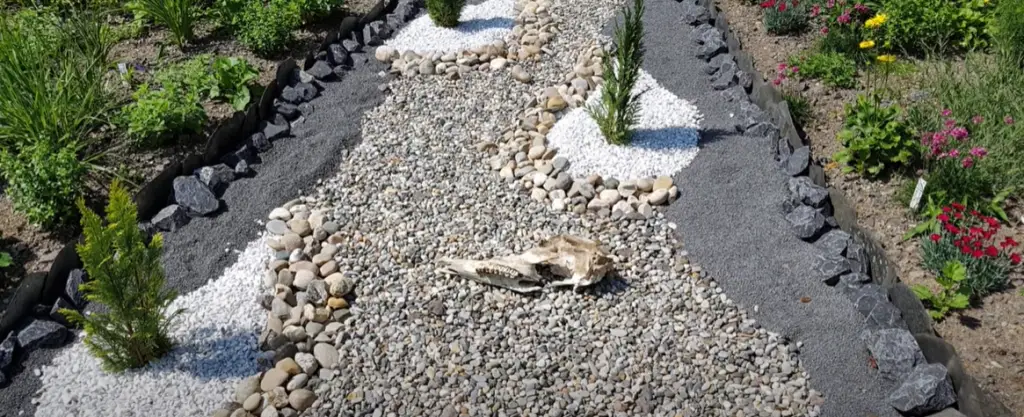
Gravel garden ideas: Choosing the right gravel
Size it right
Choosing the right size for your gravel garden is essential. Gravel comes in many different sizes, from pea-sized to large chunks. Think about how you want the space to look and feel, as well as what type of plants and animals you plan on having in your garden. Additionally, consider if you want to use gravel for pathways or edging, as different sizes may be more suitable for these purposes.
Choose color and texture
Gravel comes in a variety of colors and textures, from earthy tones to vibrant hues. Selecting the right color can bring much-needed visual interest to your garden, while selecting the right texture can give it a unique feel – think smooth stones for pathways and rough pieces for backgrounds. It’s also important to think about how certain colors and textures will complement your existing landscaping elements.
Go green with eco-friendly gravel
Using eco-friendly gravel is a great way to make your garden greener and protect the environment. Look for gravel made from recycled materials or natural stones and pebbles. Additionally, using eco-friendly gravel helps to reduce air pollution and water waste associated with producing traditional gravel.
Is gravel sustainable?
Gravel is a sustainable material when used responsibly. It can be recycled and reused, making it an excellent choice for gardens of all sizes. Additionally, gravel helps to control weeds, reduce soil compaction, and improve drainage. Gravel is also non-toxic, so it’s safe for humans, plants, and animals. Ultimately, choosing the right type of gravel for your garden can ensure that you create an eco-friendly space.
Location matters
It’s important to consider the location of your gravel garden when planning. Think about where it will get the most sunlight and how you want to use the space. It’s also important to remember that some plants may not do well in gravel gardens, while others thrive in them. Taking these factors into account can help ensure that your gravel garden is a success.

Should you opt for a gravel membrane or not?
In some cases, it may be beneficial to opt for a gravel membrane in your garden. This is a layer of coarse rocks that is placed below the soil surface and acts as a barrier between the soil and gravel. The membrane helps to keep weeds out and can help prevent water loss due to evaporation. Additionally, it will also help reduce soil compaction, which is essential for healthy plant growth. Ultimately, deciding whether or not to use a gravel membrane is up to you – just make sure you consider all factors before making your decision [2].
7 gravel garden ideas
The herb garden
This is a classic, and it’s easy to see why: the combination of gravel and herbs creates an attractive display while making it easier for plants to take root in sandier soils. The best part about an herb garden is that you can mix and match different herbs, flowers, and other greenery as much as you like.
The zen garden
Zen gardens are perfect for anyone looking to create a peaceful, calming atmosphere in their backyard. Fill the gravel bed with sand and add low-growing shrubs, succulents, evergreen trees, and other plants that require little maintenance. You can also incorporate larger rocks and stones of various shapes and sizes or even a trickling fountain.
The raised garden bed
Raised beds let you bring the warmth and beauty of gravel right up to your doorsteps – or wherever else you may need it! They’re perfect for growing vegetables, herbs, flowers, or any other plants that thrive in sandy soil. To make them extra special, use different sizes of gravel to create stunning patterns on the ground.
The rockery
Rockeries are a great way to bring the beauty of nature into your garden. Choose rocks that match the soil and plants in your garden, then use gravel beds between them to create an eye-catching landscape feature. You can also plant creeping ground covers such as thyme or moss between the rocks for a lush look.
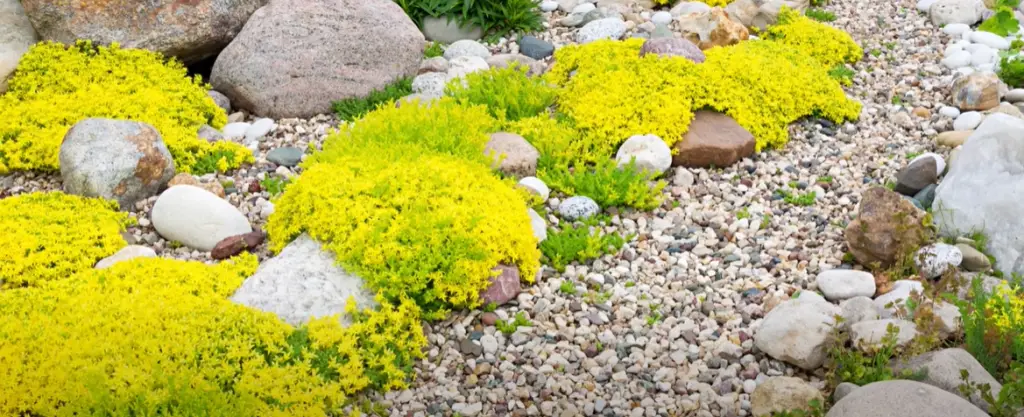
The gravel path
Gravel paths are a great solution for linking different areas of your garden together. Not only do they look attractive and help guide the eye through the space, but they’re also much easier to maintain than grass or paving stones. Choose gravel that complements the other elements in your garden, such as soil and plants, for maximum effect.
The wildlife habitat
If you want to attract wildlife to your garden, gravel is a perfect choice! Gravel beds provide an ideal surface for birds and insects to land on while offering protection from predators. You can create a mini-habitat by planting native flowers and shrubs around the gravel beds, providing food and shelter for many species.
Courtyard garden
The courtyard garden is perfect for small spaces and apartments, making the most of whatever area you have to work with. Fill gravel beds with flowering plants or succulents, add a few pieces of furniture, and incorporate lighting for a cozy, inviting atmosphere. This type of garden also requires minimal maintenance and can look great year-round.
The graveled front garden
A graveled front garden is a great way to quickly add some curb appeal to your home. Use larger pieces of gravel or pebbles combined with plants and edging to create a neat, minimalistic look that complements the facade of your house. This type of garden also requires little maintenance and won’t take too much time or effort to keep looking its best.
Container gravel gardens
Container gardens are a great way to bring some life into balconies, patios, and other small spaces. Fill planters with gravel or pebbles and then plant low-maintenance succulents, flowers, herbs, and other plants that thrive in dry soils. You can also add decorations such as figurines or wind chimes to complete the look [3].

8 Garden Decoration Ideas for Gravel Gardens
The succulent wall planter
A succulent wall planter is a great option for adding dimension and texture to your gravel garden. It requires minimal maintenance, so it’s perfect if you don’t have much time on your hands. Plus, the green foliage adds visual interest and helps to soften the hard lines of the gravel. Install one in a sunny spot and make sure that you water it regularly.
A rustic table and chairs
If you have some spare space, why not add a small outdoor seating area? A rustic table and chairs will look great against the backdrop of white or grey gravel. Add some colorful cushions for extra comfort and style. This is a great way to enjoy your garden with family and friends, plus it’ll be the perfect spot for summer barbecues.
A wind chime
Add a gentle breeze to your garden with a wind chime. They come in all shapes and sizes, so there’s sure to be one that’s right for you and your gravel garden. Hang it up near a seating area or an entranceway, and enjoy its relaxing tinkling sound whenever the wind blows through.
A mosaic path
Create a beautiful, intricate pathway with colorful mosaics set into the gravel. This is an easy way to add some visual interest and texture to your garden without spending too much money or time on installation. Plus, it will help keep you from tracking gravel into your house.
A birdbath
Attract wildlife to your garden with a bird bath. You can either buy one that’s ready-made or get creative and make your own. Place it in an area of the garden where birds will feel safe, such as near some shrubs or trees, and enjoy watching them come to take a dip.
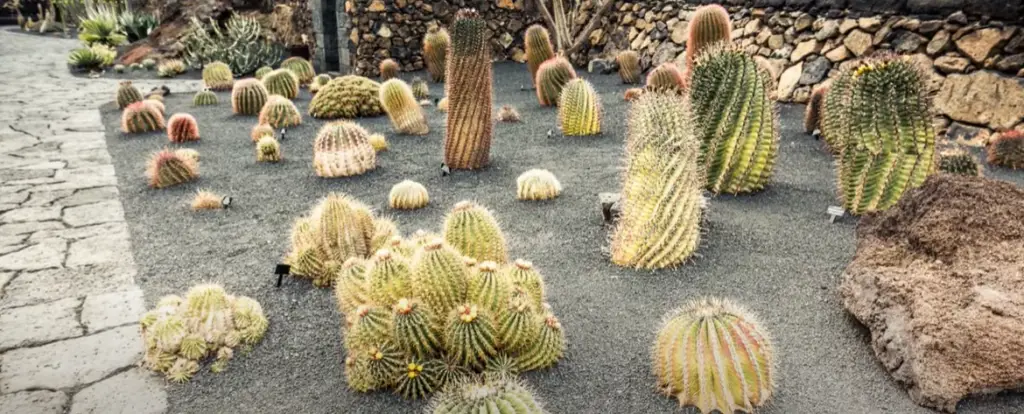
An outdoor fireplace
Enjoy those balmy summer nights with an outdoor fireplace in your gravel garden. It’ll give the space a cozy vibe and provide warmth for those times when you need it. Plus, it doubles up as a barbecue too, so you can use it for cooking up tasty treats for friends and family.
Statues and sculptures
Add a touch of whimsy to your gravel garden with statues and sculptures. Whether you go for something traditional or modern, it’ll be sure to draw the eye and bring character to the space. Place them on top of small mounds of gravel or choose spots where they’ll reflect in the sun – either way, they’re guaranteed to look stunning.
A vertical planter
If you want to make use of every inch in your garden, why not try a vertical planter? Fill with vibrant flowers, herbs, or succulents, and enjoy watching them grow against the white backdrop. It’s a great way to add some green without taking up too much floor space. Plus, it’ll look great against the gravel.
So there you have it – eight garden decoration ideas for your gravel garden. With a few simple changes, you can create a visually interesting and enjoyable space that you and your family will love. Just remember to stay creative and have fun with it!
How to create a gravel garden?
Creating a gravel garden is an easy and low-maintenance way to add texture, color, and interest to your outdoor space. To get started on your own gravel garden, there are some important steps you’ll need to take:
- Choose the Right Location – Select a spot in your yard with good drainage, as standing water will quickly ruin a gravel garden. If you don’t have an area that naturally drains well, you may want to consider installing underground drainage channels or French drains before beginning work on your project.
- Measure the Area – Once you’ve chosen the location for your gravel garden, use measuring tape or string to measure out the exact dimensions of the space. This will help you determine exactly how much material you’ll need to complete the project.
- Prepare the Soil – Once you have the measurements, dig up the soil in your designated area and make sure it is weed-free. You can also add a layer of landscape fabric beneath the gravel to further inhibit weeds from growing up through your gravel garden.
- Install Edging – To give your gravel garden a neat, finished appearance and keep it separate from other parts of your yard, install some edging around the perimeter of your space. Options for edging materials include stone, wood, metal, or plastic.
- Lay Gravel – Now is the time to lay down the gravel cover! Depending on the look you’re going for, you can choose from a variety of gravel types including pea gravel, crushed stone, and river rocks. Spread it out evenly in your designated area and use a rake to make sure it is level.
- Add Accessories – To make your gravel garden feel extra special, consider adding some decorative elements such as stones, sculptures, or another outdoor decor. Rake the gravel occasionally to keep it looking neat.
Creating a gravel garden is an easy way to add visual interest to any outdoor space without having to spend too much time on maintenance. With these tips in mind, you can create your own stunning and functional gravel garden [4]!
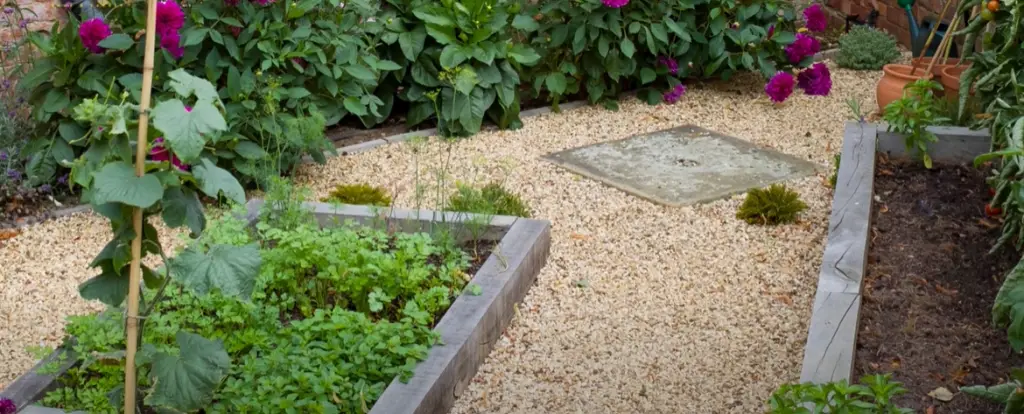
How to maintain a gravel garden?
Maintaining a gravel garden is an easy and economical way to keep your outdoor living space looking neat and tidy. Here are a few tips on how to maintain your gravel garden:
- Weed regularly: Weeds can quickly take over gravel gardens if left unchecked, so it’s important to pull any weeds you see as soon as possible. If the weeds have already taken root in the soil beneath the gravel, consider using an herbicide or natural weed control methods like mulching.
- Keep plants healthy: Regularly check for signs of disease or insect infestations on your plants and treat them immediately with appropriate treatments. Make sure to water your plants according to their needs and pay attention to when they need to be fertilized.
- Spread fresh gravel: Over time, the gravel in your garden can become compacted and less effective at preventing weed growth. To keep it looking its best, spread a layer of fresh gravel every few years or whenever you notice it becoming patchy or uneven.
- Clear debris: Gravel gardens don’t require much maintenance, but they do need to be kept free of debris like leaves and twigs. Be sure to clear away any debris that accumulates to prevent disease and insect infestations from taking hold in your garden.
- Edge the borders: The edges of your gravel garden should be clearly defined for it to look its best. Use edging materials such as bricks or stones to create a neat perimeter.
FAQ
What can I use for a gravel garden?
For gravel gardens, you can use any type of aggregate material that is large enough to provide cover and retain moisture. Popular choices include river rocks, crushed rocks, pea gravel, and sea shells. Each of these materials has its own unique look and characteristics that can be used to create a beautiful landscape. You should also consider the color, texture, size, drainage, and cost when selecting the right type for your garden. To ensure proper drainage in the garden bed, it is recommended that you use a layer of sand or soil below the gravel material before planting.
Can I lay gravel on top of the soil?
Yes, you can lay gravel on top of the soil. However, it is important to note that if you are using a heavy type of gravel such as river rocks or crushed stones, then it is best to provide some kind of support for the soil below so that it does not become compacted. This can be done with a layer of sand and/or soil before laying down the gravel. Additionally, you should consider the drainage and size of your chosen material when determining how thick this layer should be. You may also want to consider adding edging around your gravel garden bed to keep the material from washing away during heavy rainstorms. Finally, regular maintenance such as raking and weeding will help keep your new garden looking its best.
What gravel is best for gravel gardens?
The best type of gravel for gravel gardens will depend on your specific needs and desired look. Popular choices include river rocks, crushed stones, pea gravel, and sea shells. Each of these materials has unique characteristics that can help bring out the beauty in your garden. When choosing a material, consider the color, texture, size, drainage, and cost to find the right one for your garden. Additionally, you should provide some kind of support layers such as sand or soil before laying down the chosen material to ensure proper drainage in the garden bed. Regular maintenance such as raking and occasional weeding may also be necessary to keep your new garden looking its best.
Are there any plants suitable for a gravel garden?
Yes! Many types of plants are suitable for a gravel garden. You can choose low-growing, drought-tolerant varieties such as succulents and cacti to fill in the gaps between stones or larger shrubs and trees to provide shade and privacy. Additionally, you may also want to consider adding some flowering annuals or perennials to bring color and texture into your garden design. Finally, be sure to select a variety that is native to your region so it can thrive in the local climate. With careful planning, you can create a beautiful oasis with gravel and plants working together as one!
What do you put on the soil before gravel?
Before you lay gravel or any type of aggregate material on top of the soil, it is important to provide some kind of support layer. This could be a layer of sand or soil before laying down the chosen material to ensure proper drainage in the garden bed. Additionally, you should consider the drainage and size of your chosen material when determining how thick this layer should be. Regular maintenance such as raking and weeding will also help keep your new garden looking its best. It’s also a good idea to add edging around your gravel garden bed to keep the material from washing away during heavy rainstorms.
How deep should garden gravel be?
The depth of garden gravel will depend on the size and type of material you are using. Generally, it is best to use a layer that is at least 2-3 inches thick. If you are using a heavier type such as river rocks or crushed stones, then it may be necessary to provide some kind of support layer beneath the gravel such as sand or soil before planting. Additionally, consider adding edging around your gravel garden bed to keep the material from washing away during heavy rainstorms. Finally, regular maintenance such as raking and weeding will help keep your new garden looking its best.
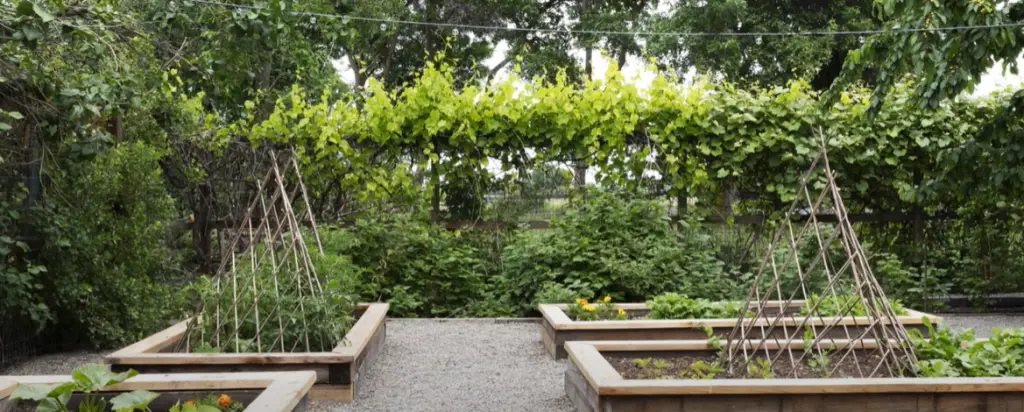
Should I put sand under my gravel?
Yes, it is generally recommended to put a layer of sand or soil before laying down the chosen gravel material. This will help prevent the compaction of the soil below and allow for proper drainage in the garden bed. Additionally, consider adding edging around your gravel garden bed to keep the material from washing away during heavy rainstorms. Finally, regular maintenance such as raking and weeding will help keep your new garden looking its best.
How do I make my gravel garden look good?
A well-planned gravel garden can be a beautiful addition to any outdoor space. To make your gravel garden look its best, start by choosing the right type of material for the job. Popular choices include river rocks, crushed stones, pea gravel, and sea shells. Each of these materials has unique characteristics that can help bring out the beauty in your garden. Additionally, provide some kind of support layers such as sand or soil before laying down the chosen material to ensure proper drainage in the garden bed.
Do weeds grow in gravel?
Yes, weeds can grow in gravel. Although the gravel may provide some barrier to unwanted plants, regular maintenance such as raking and occasional weeding is important to keep your new garden looking its best. Additionally, consider adding edging around your gravel garden bed to keep the material from washing away during heavy rainstorms. Finally, be sure to select a variety of plants that are native to your region so they can thrive in the local climate. With careful planning and regular maintenance, you can create a beautiful oasis with gravel and plants working together as one!
Useful Video: 5 Creative Gravel Garden Ideas for a Water Wise Garden
Conclusion
Gravel gardens are a beautiful and easy way to add texture and interest to any outdoor space. They are inexpensive, low-maintenance, and require little effort to design. With careful selection of plants and gravels, they can create an attractive habitat that is beneficial for wildlife too. Gravel gardens offer flexibility in terms of size and shape, making them ideal for those with limited garden spaces or budgets. While they may not suit everyone’s taste, gravel gardens provide a unique alternative to traditional lawn or flowerbed gardens. With their diverse range of textures and colors, gravel gardens can be used as an eye-catching centerpiece in any garden or yard.
References:
- https://www.thespruce.com/all-about-gravel-gardens-5224625
- https://www.countryliving.com/uk/homes-interiors/gardens/a40905588/gravel-garden-ideas/
- https://www.homesandgardens.com/gardens/gravel-garden-ideas
- https://www.finegardening.com/article/how-to-create-a-gravel-garden





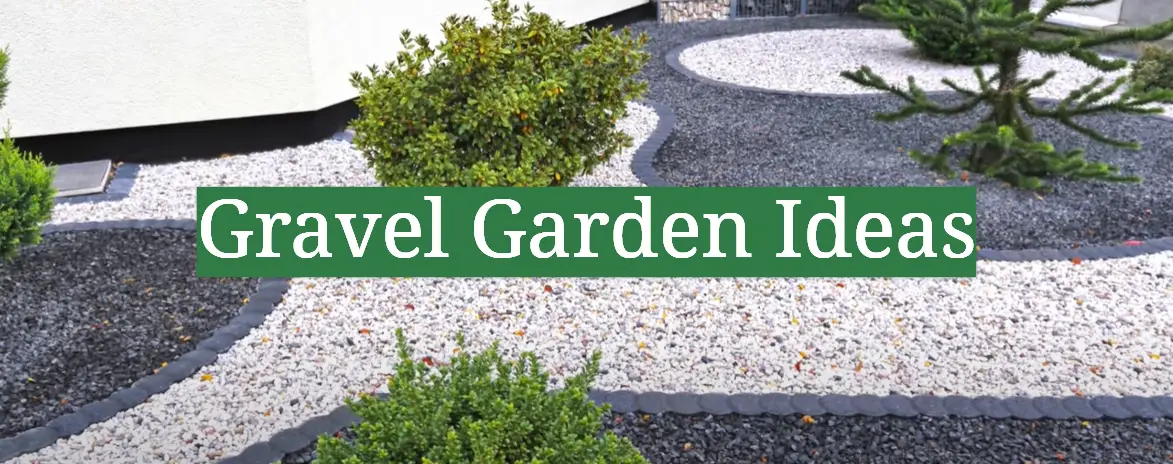




Leave a Reply
View Comments